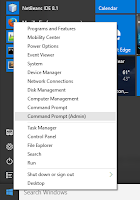 |
| Image source: www.howtogeek.com |
Windows 10, 8, and 7 have a feature for create Wi-Fi Hotspot portable it called Mini Virtual Wi-Fi. Now, let's read this section for create virtual wifi hostspot from your windows.
1. Click right from your start menu, and than choose "Command Prompt (Admin)". You can look at the pictures below.
 |
netsh wlan set hostednetwork mode=allow ssid=HOSTSPOTNAME key=PASSWORD8DIGITSNotes:
HOSTSPOTNAME = the name for your WiFi Hotspot
PASSWORD8DIGITS = the password for your Hotspot, more than 8 digits
3. Now start the network, type and Enter this command.
netsh wlan start hostednetwork4. After it, you need to sharing internet connection you have . Open the Network Connections. (Type network connection from search windows box).
5. On the adapter that have internet connection, click right => properties => click to Tab Sharing => check "Allow other network users to connect through this computers Internet connection". And on the "home networking connection", choose the name of Microsoft Hosted Network Virtual adapter. Look at below.
6. After it, click "OK".
Read more:
How to disable windows update Windows 10
Simple Ways How to Hide a Files or Folders on Windows
Finish, and now you can share internet connection using your laptop for your smartphone or other device.
Paper 4Share - How to turn on Wi-Fi Hotspot in Windows 10 / 8 / 7 Using Command Prompt (CMD)


